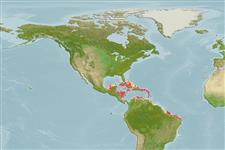Common names from other countries
>
Gobiiformes (Gobies) >
Gobiidae (Gobies) > Gobiinae
Etymology: Coryphopterus: Greek, koryphe = summit + Greek, pteron = fin, wing (Ref. 45335).
More on authors: Böhlke & Robins.
Environment: milieu / climate zone / depth range / distribution range
Ecología
marino asociado a arrecife; rango de profundidad 0 - 13 m (Ref. 13442). Tropical; 25°N -
Western Atlantic: Florida Keys, USA to Central America (Ref. 7251). Also Bahamas, Caribbean, including Antilles (Ref. 26938).
Tamaño / Peso / Age
Maturity: Lm ? range ? - ? cm
Max length : 3.0 cm TL macho / no sexado; (Ref. 7251)
Espinas dorsales (total): 6 - 7; Radios blandos dorsales (total): 9; Espinas anales 1; Radios blandos anales: 9. Translucent yellowish gray with iridescent blue markings on snout and upper part of eye; alternating yellow and narrow blue lines extending posteriorly from eye onto anterior body (Ref. 13442).
Lives in coral heads in fairly deep water. Usually solitary, but sometimes swims close to reef in small groups.
Life cycle and mating behavior
Madurez | Reproducción | Puesta | Huevos | Fecundidad | Larva
Robins, C.R. and G.C. Ray, 1986. A field guide to Atlantic coast fishes of North America. Houghton Mifflin Company, Boston, U.S.A. 354 p. (Ref. 7251)
IUCN Red List Status (Ref. 130435)
CITES (Ref. 128078)
Not Evaluated
Threat to humans
Harmless
Human uses
Acuario: Comercial
Más información
ReferenciasAcuiculturaPerfil de acuiculturaRazasGenéticaElectrophoresesheritabilidadEnfermedadesProcesamientoMass conversion
Herramientas
Special reports
Download XML
Fuentes de Internet
Estimates based on models
Preferred temperature (Ref.
115969): 27 - 28.2, mean 27.6 (based on 510 cells).
Phylogenetic diversity index (Ref.
82804): PD
50 = 0.5001 [Uniqueness, from 0.5 = low to 2.0 = high].
Bayesian length-weight: a=0.01023 (0.00477 - 0.02194), b=3.02 (2.84 - 3.20), in cm Total Length, based on LWR estimates for this (Sub)family-body shape (Ref.
93245).
Nivel trófico (Ref.
69278): 2.9 ±0.4 se; based on size and trophs of closest relatives
Resiliencia (Ref.
120179): Alto, población duplicada en un tiempo mínimo inferior a 15 meses (Preliminary K or Fecundity.).
Fishing Vulnerability (Ref.
59153): Low vulnerability (10 of 100).
